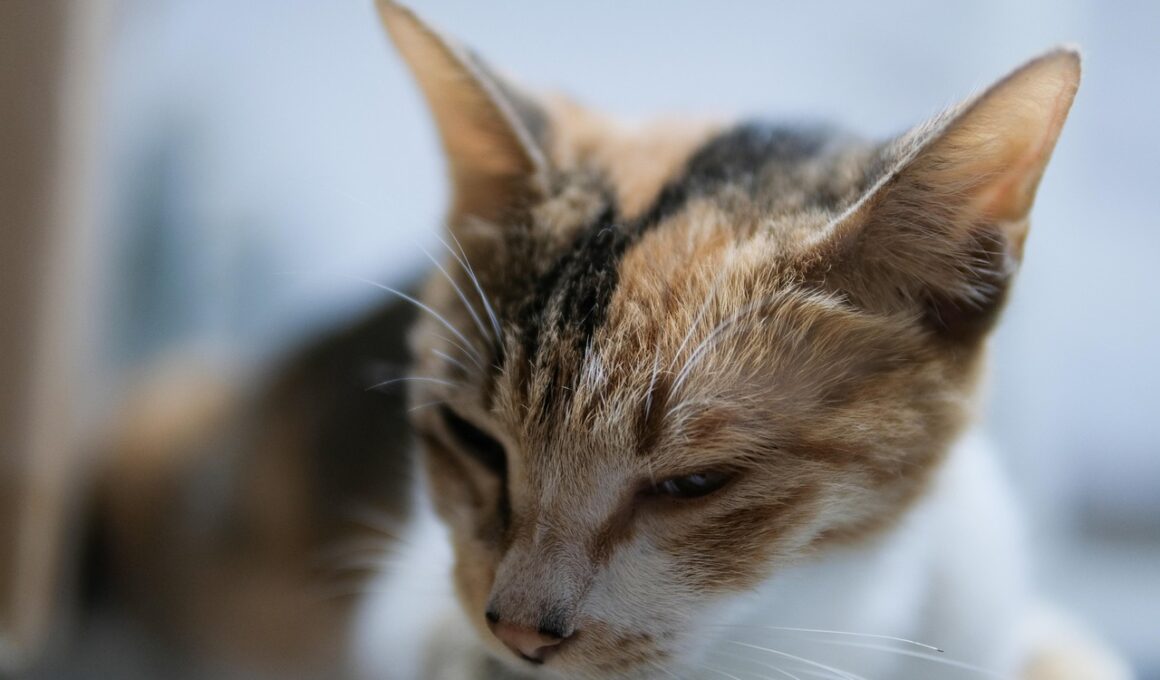Calm and Gentle Approaches to Training Sensitive Cats
Training sensitive cats requires understanding their unique personalities and needs. These cats often display anxiety or fear in response to typical training methods. Therefore, adopting gentle approaches is crucial for success. Start by creating a calm environment where the cat feels safe. Use soft tones and slow movements to avoid startling them. Establishing a routine can also provide comfort and predictability, helping your sensitive cat thrive. Consistent timings for meals and play can create a sense of security. Moreover, patience is essential. Sensitive cats may need more time to understand commands and trust their handler. Use positive reinforcement techniques like treats or affectionate petting when they respond correctly. These rewards not only motivate but help build confidence. Additionally, short training sessions are beneficial since they prevent the cat from feeling overwhelmed. If your cat shows signs of stress or discomfort, take a step back and allow them to recuperate. Lastly, ensure you respect their boundaries, and don’t force interactions. Creating a trusting relationship based on respect will enhance your training sessions and improve communication with your sensitive feline friend.
One effective way to connect with sensitive cats is through gradual desensitization techniques. This involves introducing them to training stimuli or environments slowly, allowing them to adjust at their own pace. For example, when teaching your cat to accept a leash, start by allowing them to explore the leash in a secure space. Gradually progress by rewarding them for calm behavior around it. Each small victory contributes significantly to their training journey. Moreover, consider using play as a form of training, utilizing interactive toys that captivate their interest without overwhelming them. Integrating play into learning makes it enjoyable. This approach emphasizes that training can be fun rather than intimidating. As a result, your cat may become more engaged and responsive to commands. Remember to incorporate breaks during sessions to prevent fatigue or frustration. Providing a safe retreat where they can relax is important. Always observe their body language closely; signs of stress, such as hiding or excessive grooming, indicate the need to halt training. When interventions are made based on their responses, it strengthens the bond between you and your cat. Remember, a tailored approach is key to training sensitive felines effectively.
Understanding Feline Body Language
A vital aspect of training sensitive cats is understanding their body language. Cats communicate through subtle behavioral cues, and recognizing these signs can significantly improve your training sessions. Look for common indicators like tail position, ear orientation, and eye contact. A relaxed body posture generally indicates comfort, while a puffed-up tail or flattened ears often signal fear or stress. If your cat displays these signs, it’s crucial to pause the training and give them space. Allow them to approach the training exercises on their own terms. Additionally, spending quality time engaging with your cat outside training sessions builds trust. Simple activities like gentle brushing or playing can foster a positive bond. Prioritizing their emotional well-being shows that you respect their boundaries. Also, always maintain a positive atmosphere during training. Use encouraging words and rewards, which help create a more inviting environment. A calm disposition from you helps reduce their anxiety levels, promoting a sense of security. Positive interactions not only enhance communication but also teach your cat that training is a rewarding experience. Ultimately, this understanding ushers in better cooperation and strengthens your relationship with your feline companion.
Another effective technique for training sensitive cats is to utilize scent as a motivational tool. Cats possess a strong sense of smell, and leveraging this can encourage participation without added stress. Infusing training treats or toys with appealing scents can capture their interest. Try using catnip or specific aromas that your cat enjoys, making the training sessions more enticing. Additionally, always associate training with positive sentiments. For example, before commencing a training session, engage your cat in a fun or playtime activity that they love. Following it with training can help them associate the experience with enjoyment rather than pressure. In addition to scent, visual aids can also be beneficial. Introducing a clicker can serve as a clear signal when they respond correctly. The sound of the clicker can be combined with treats, reinforcing positive behavior. This method removes any ambiguity during training, promoting quicker learning. Similarly, ensure training materials are easy to handle and not overwhelming. Choose colorful toys, but avoid overly stimulating gadgets. Through this strategic use of sensory tools, you’re creating an enjoyable and effective training experience for your sensitive cat.
The Role of Environment in Training
The training environment can significantly impact a sensitive cat’s ability to learn. A cluttered or noisy space may cause distractions, hindering their focus. Therefore, choose a quiet, familiar room for training sessions. Familiar surroundings help alleviate anxiety and enhance receptiveness. Additionally, consider temperature and lighting in the training area. Ensuring the environment is comfortable can help your cat remain calm during sessions. Dim lighting or harsh brightness may lead to discomfort, so create a soothing atmosphere. Incorporating their favorite bedding or toys into the training space can provide additional security, helping them feel more relaxed. Also, try to minimize any potential disruptions, such as loud appliances or sudden movements from other pets. Maintaining a peaceful space during training is crucial for your sensitive feline. Furthermore, always remain attentive to your cat’s limits. The training should not feel forced, but rather a guided experience at their pace. If they exhibit signs of discomfort, reconsider the environment or method being used. Respecting their boundaries not only reinforces their trust in you but contributes to a more successful, enjoyable training journey.
When training sensitive cats, consistency is essential. Establishing a routine aids your cat in understanding what to expect, which significantly reduces anxiety levels. Consistent cues and rewards create a clear communication pathway between you and your cat. Always use the same phrases or signals for commands to avoid confusion. Similarly, the timing of rewards should be immediate, linking the behavior with the reinforcement clearly. Gradually, your cat will understand the connection between correctly following commands and receiving rewards. Additionally, feel free to adapt your techniques based on your cat’s progress. Some sensitive cats may excel in certain methods while finding others intimidating. Revisiting previous steps can solidify learning, promoting confidence. Moreover, documenting progress helps in pinpointing effective strategies. Journaling the reactions, preferences, or any setbacks observed aids in fine-tuning your approach. Attending workshops or online forums can also enhance your skills and provide new insights. Connecting with other cat owners can give you fresh perspectives and techniques, fostering a greater knowledge base. Remember, your goal is to create a supportive environment that encourages learning. Patience, consistency, and observation can lead to rewarding results in training sessions.
Encouraging Positive Experiences in Training
Creating positive experiences during training sessions is paramount for sensitive cats. Every action should inspire confidence rather than fear. Focus on making each session short and enjoyable. Overloading them with information can be overwhelming, leading to withdrawal. Typically, sessions lasting about five to ten minutes are optimal for maintaining their interest. Ending the session on a positive note, regardless of progress, ensures your cat leaves with a good learning experience. Using calming music can also create a pleasant atmosphere and encourage relaxation. When introducing new commands, patience is your ally. If your cat struggles, don’t express frustration; instead, encourage them gently. This nurtures a trusting relationship. Moreover, be creative with rewards. In addition to treats, consider incorporating playtime or affectionate grooming as rewards. The pursuit of a feather toy or engaging with a laser pointer can reinforce desired behaviors. Cats respond incredibly well to varied approaches. Celebrating achievements, even small ones, inspires their enthusiasm for training. Additionally, participating together strengthens your bond, enhancing the overall training atmosphere. Ultimately, encouraging a continual cycle of positive experiences is vital. This approach not only nurtures your cat’s personality but also enhances their confidence and willingness to learn.
In conclusion, training sensitive cats requires a gentle and thoughtful approach. Understanding their unique needs while employing effective techniques lays a solid foundation for successful training sessions. Every sensitive cat has its comfort zone, and respecting it is instrumental for creating a strong bond. Choose your environment wisely, and ensure it is soothing and free of disturbances. Utilize positive reinforcements and sensory tools to make the experience enjoyable, catering to their individual preferences. Consistency and patience stand out as key components of the process, ensuring your cat feels secure and valued. Recognizing and understanding their body language while adapting your methods according to their comfort can significantly enhance learning. Additionally, fostering a positive experience throughout training builds trust and encourages cooperation. Remember that your cat’s emotional stability is vital, and minimizing stress should always be a priority. By employing these calm and gentle approaches, you nurture a strong relationship with your cat while effectively training them. In this regard, every session can transform into an opportunity for growth, connection, and enjoyment. With the right mindset and approach, sensitive cats can thrive in training, making the journey rewarding for both you and your feline companion.


